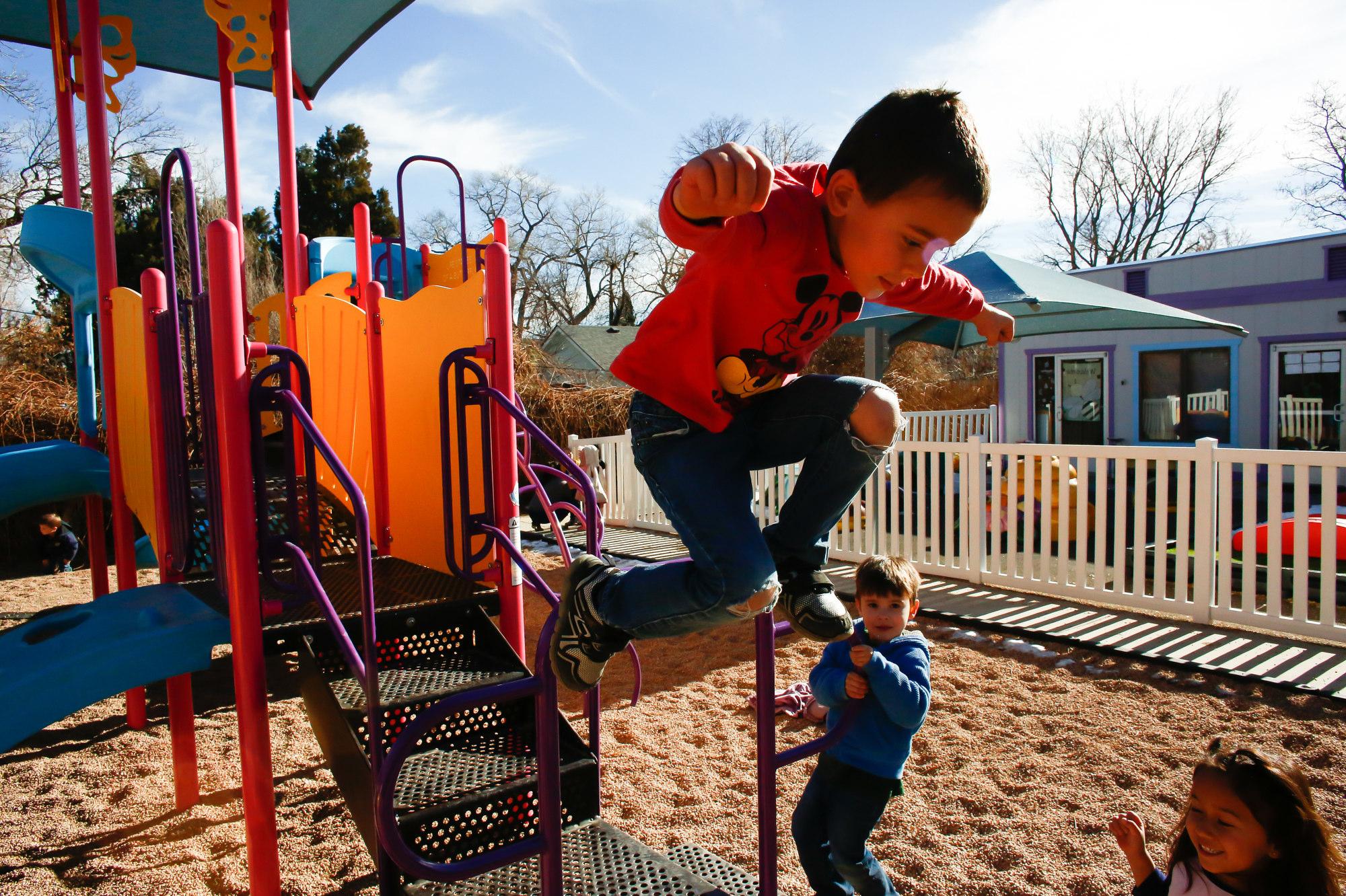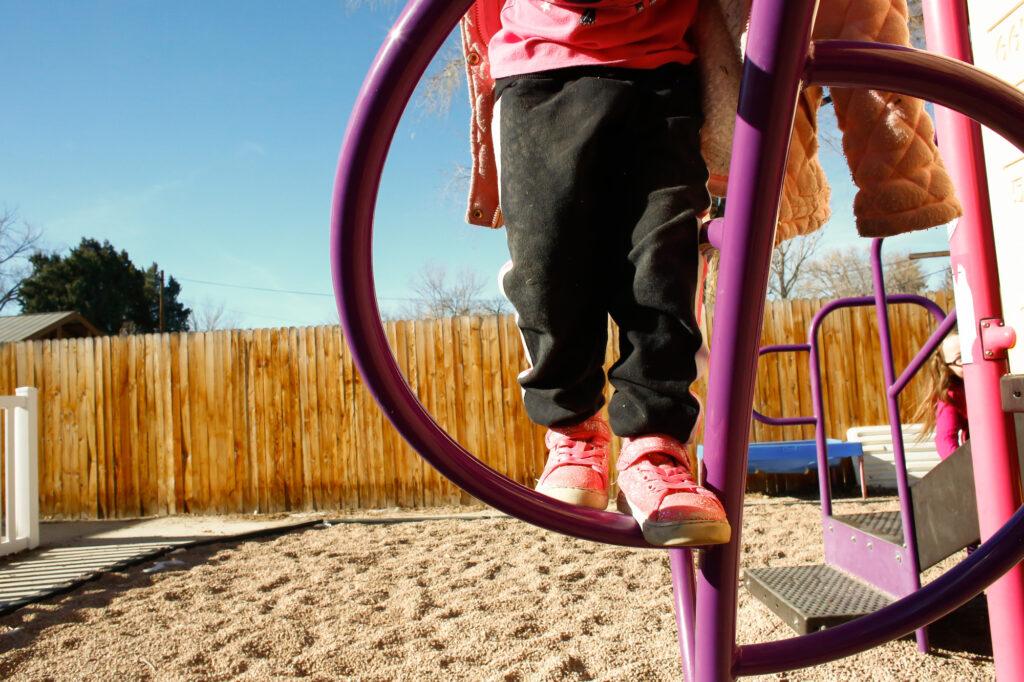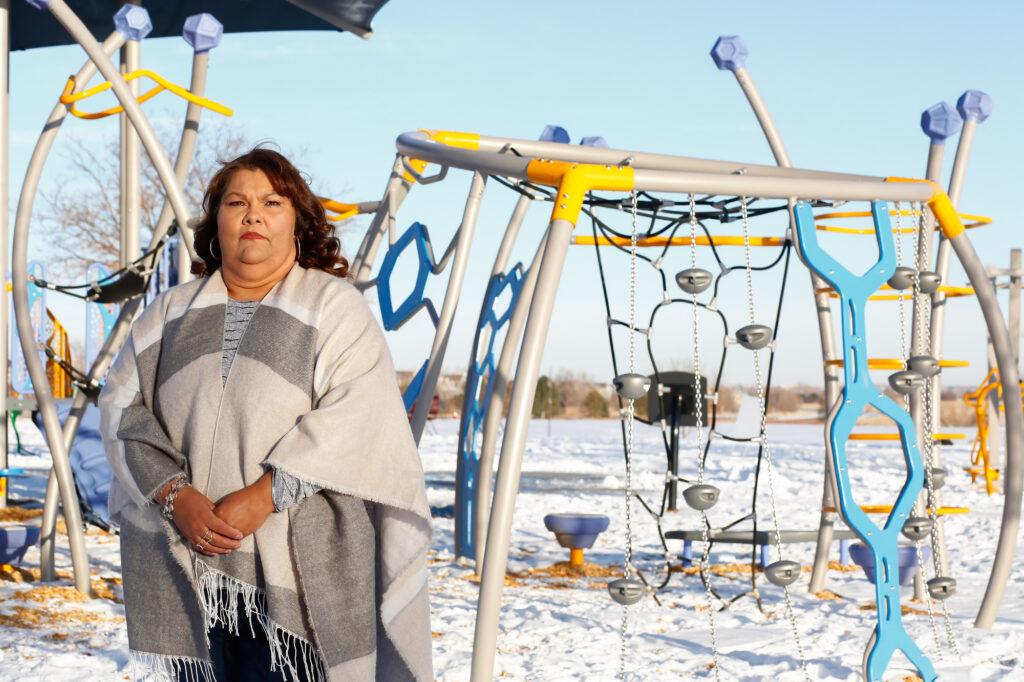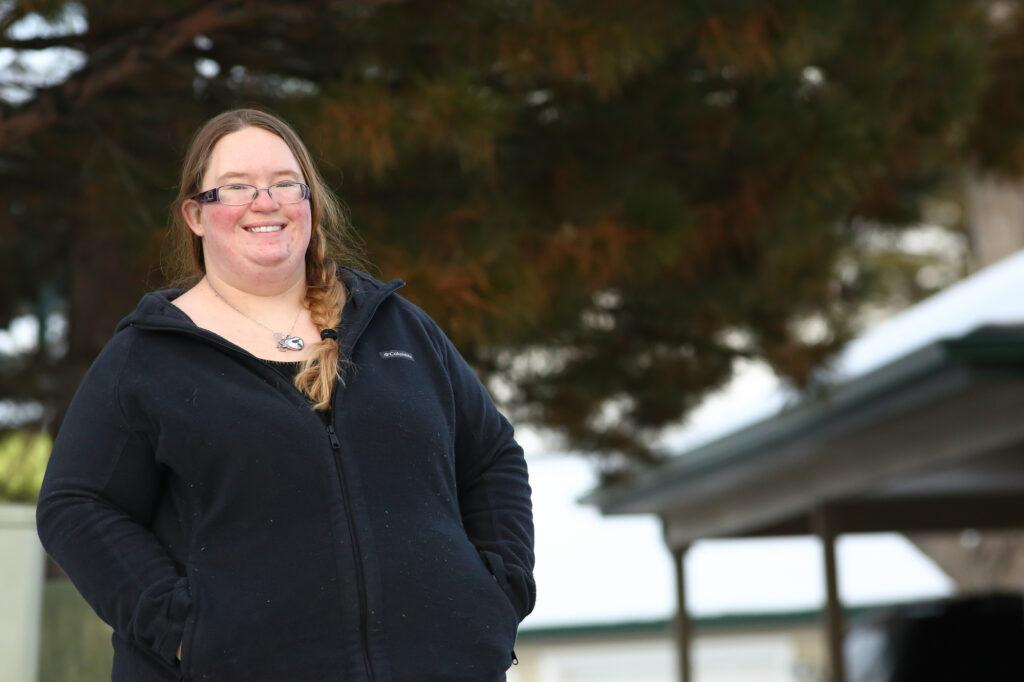
Cathryn Schmidt is an early childhood educator. Not a new one. A 10-year veteran.
She works three jobs to survive, one of them is a desk job at a 24 Hour Fitness. It's a 70-hour work week.
“I make $17.33 an hour,” she said of her Denver teaching job.
Schmidt has a bachelor’s degree and a dual master’s degree in early childhood education and curriculum design and implementation, a director’s license, a teacher’s license and dozens of certificates.
But Schmidt said she’s lucky. Her degrees have boosted her wage to about $32,000 a year.
On average, most Colorado child care teachers who lead classrooms with children ages 0-4, make on average $26,875 a year. Their aides and assistants make even less. CPR News contacted dozens of early educators and directors and their stories are similar.
Naj’la Kimball teaches 4-year-olds. Before the pandemic, she put in 14-hour work days, six days a week, working from 7 a.m. to 4:00 p.m. at the preschool and then 4:30 p.m. to 9:00 p.m. as a stocking manager.
“The thing that keeps me going really is my kids,” Kimball said, referring to her class of 4-year-olds. “They’ve survived this whole COVID trauma I think because of the consistency myself and my co-teacher have been able to provide.”

Schmidt and Kimball have stayed in their classrooms, they say, because of their deep dedication to overseeing children’s learning during what science says are the most important years of brain development. But they, along with their peers, are near the breaking point. Nationally, one third of early childhood education staff leave their jobs annually. That’s four times higher than for elementary school teachers.
Half of Colorado’s early childhood staff changed jobs in the past three years.
“If things don’t change soon, I feel like the backbone of everyone else’s existence is going to break a little bit,” Kimball said. “It’s really important that we’re available so that everybody else can continue working.”
The Shortage Of Qualified Has Gotten Worse
The state doesn’t have enough people to take care of children while parents work. The number of children under age four in Colorado is expected to increase 10 percent over the next two years and 22 percent by 2026.
“It's going to take a robust workforce to be able to staff all of that,” said Heather Hanna, deputy director, of the Early Childhood Council Leadership Alliance.
The hurdles are massive. Not only is the pay low with challenging working conditions, but there are education requirements for the job, backed by brain science, to reflect the complexity of the job. Many child care workers struggle to access that training through traditional higher education pathways while working demanding jobs.
Seventy percent of Colorado’s child center directors report finding qualified staff as a top challenge. It takes an average of two and a half months to fill vacant positions.
“We have so many positions open and not enough qualified teachers to fill those positions,” said Tammy Sanchez, owner of ECE Colorado Substitutes, a consulting, recruitment and substituting company.
Sanchez herself has worked in every position in the industry and said many drift into the industry now because they just need work.
“We’re not finding a lot of people that are coming into this industry because they want this career, because to them, it isn’t a career when they’re only making almost close to minimum wage. Is it a career that they’re looking forward to? No, because it’s not sustainable. They can’t live off this.”
Advocates hope the moment has finally arrived for equity for child care professionals, with a governor who “gets it.”

Gov. Jared Polis said the state needs more academic pathways into the profession and higher wages.
“The two really go hand in hand,” he said in a December interview with CPR News. “How do we improve the quality of the workforce to do the right science-driven early childhood education, the high quality it needs to pay better and needs to compete?”
But it will take more than a few innovative pilot programs to build an adequate pipeline of workers.
“To be honest, our field has been dying for a long time,” said Katie McDonald, owner of Meadows Early Learning in Parker.
The fundamental problem is that as brain science threw a bright light on the importance of a child's early years, the expectations of what early childhood teachers should know and be able to teach has also increased.
Ninety percent of brain development occurs in the first three years of life — more than 1 million new neural connections are formed every second. What happens to young children during those years can often set their path in life.
The better educated and trained the early childhood workforce, research shows, the higher quality the caretaking. That means, as we better understand what growing brains need, we need a more professional workforce to help deliver it.
Decades of research has shown that investing in high-quality preschool pays in spades later. Those children have a higher level of degree attainment, higher earnings, and a lower rate of special education needs. They create greater tax revenues, lower crime rates and need less public assistance. It also reduces deficits and strengthens the economy.
A National Academy of Science report found that educators of young children, including infants and toddlers, need the same high level of knowledge and competencies as teachers of older children. The report found education qualifications and compensation of early educators should be equivalent to those of K-12 teachers.
Despite this, lower wages are the norm — many early childhood educators have similar responsibilities but earn half as much as Kindergarten teachers on average. And the traditional methods of getting more training aren’t within reach for most child care workers. The qualifications required, and the compensation they receive, doesn’t reflect the complexities of their job.
“There’s still the stigma that we’re babysitters,” said Katie McDonald of The Meadows Early Learning Center. “We got a lot of resumes from bartenders, hostesses, people who have worked in assisted living facilities and they seem to think that they’re just going to come and hang out with kids all day. And then they become very intimidated when they realize that we actually have a full curriculum with developmental milestones — and we plunge our own toilets.”
“We Are Not Investing In The Educators”
The societal and economic benefits are so huge that the issue of providing high quality child care has bipartisan support. But often lost in the discussion is that the huge return on investment from building early childhood education programs “is on the backs of the workforce, that we are not investing in the educators,” said Bill Jaeger, an expert in early childhood education at the Colorado Children’s Campaign.
“Our early childhood educators are 98 percent women and disproportionately women of color,” he said. “So, it's been too easy, and I would put advocates in that bucket as well, to talk about the value of early childhood education, without talking about the value of the educators that are doing the work.”
Provider Katie McDonald said a big portion of the workforce are moms with children who take advantage of free child care often offered as a perk because “quite honestly, they can’t afford to work anywhere else and pay for child care.”
Polis calls it a gender equity issue.
“If you value a woman's participation in the workplace, if we value the ability for single parents to be able to support their families and not have to go on the government dole, then of course, you have to look at those child care years now,” Polis said.
Experts say the inequity for child care workers goes back to well before the end of the 19th century when child care “was generally associated with the poor, minorities, and immigrants and were stigmatized as charitable and custodial.” Pamela Harris, president and CEO of Mile High Early Learning, Denver’s largest and oldest provider of subsidized quality early care and education, noted the issue is still mired in the same arguments it was decades ago.
The Biggest Barrier Is Pay
The people responsible for arguably the most significant years in a human being’s life — early childhood educators — have a median wage in Colorado of $13.79 an hour. The jobs often have no benefits like medical care or paid time off.
That wage is comparable to low-paid service jobs, and they are often paid less than dog walkers and janitors. Numerous studies have documented that many who work in early childhood education have unlivable wages.
Pay is so low, in fact, that a third of Colorado’s early childhood workforce receives public assistance to make ends meet.
Take Delia Cordova.
She’s been an early childhood teacher for 21 years.
“It’s been a struggle,” she said. Cordova said she needed public housing assistance for 14 years. Even then, her rent was $900. Up until two years ago, Cordova qualified for Medicaid and food stamps. The 49-year-old has no sick leave and can’t afford health care insurance — paying for it would take half of her paycheck.
The single mom had three children to raise and prepare for college. So for five years, up until a year ago, she wrapped up her teaching job at 4:30 p.m. Then, from 6:00 till sometimes midnight, she cleaned office buildings. Her children suffered, she said.

One of her sons "went through all of high school not having me home in the evenings,” she said. “My daughter went through most of high school and all of middle school, when she needed me. And I wasn’t there.”
Cordova damaged her knees so much from her cleaning she can’t sit on the floor anymore with the children in her classroom. The vast majority of early childhood workers don’t last as long as Cordova.
“I can't stress enough how important the benefits are … health insurance, retirement plans, those safety nets — not having that available, that’s a big driver of turnover,” said Diana Schaack, a professor at the University of Colorado Denver who has studied burnout and stress in the early childhood workforce.
One study she conducted surveyed more than 4,000 educators in Colorado and found that higher wages, benefits and strong collaborative leadership led to less teacher turnover.
“The number one reason we lose highly qualified individuals is we simply can’t pay them enough,” said Ashley Henshaw, director and co-owner of Stepping Stones Early Learning Center in Littleton. “We’re constantly trying to find ways to bring in more money for staff without gouging the parents.”
Workplace Conditions Contribute To Burnout, High Turnover And Recruiting
One local study found that teachers’ emotional exhaustion stems from lack of job control, a lack of collegial relationships, and children’s behavior that they perceive to be challenging. Cordova herself has noticed a big increase in challenging behaviors in children over the last eight to 10 years, a feeling echoed by many of her follow professionals.
“It frustrates me that I don't have that training for these challenging behaviors,” Cordova said. “I was telling the girls, ‘I wonder if there’s any kind of classes we could take for all these challenging behaviors and sensory issues?’”
Provider Katie McDonald recalled one of her new employees quitting after getting kicked by a 3-year-old.
“She’s like, ‘I can go work at the gas station next door and make more money and not get hit by a 3-year-old.’”
Early childhood teachers must meet the demands of children whose first language isn’t English, who may have trauma and those who come with a whole range of cognitive and emotional needs.
Rebecca Kantor, dean of the University of Colorado Denver’s School of Education and Human Development, said because shortages are so pronounced, teachers with lower educational attainment are recruited, and they are more likely to leave feeling defeated. When teachers leave, a third of directors say they notice an increase in children’s challenging behaviors.
“It’s a stressful environment,” said CU Denver’s Diana Schaack.“Teachers need planning time. They need breaks, they need health care benefits. They need professional development for when there are children who exhibit behaviors that teachers find challenging.”
Cost Is A Significant Barrier To Caregiver Education
One strategy underway is to “professionalize” the early childhood field, to create a number of post-secondary pathways to advance workers’ skills and knowledge.
“This is a professional job and the qualifications and the compensation need to be elevated to reflect the professional nature of the job,” said Schaack.
Colorado has a number of pathways to get certified to work in an early childhood classroom or to direct a center and it also has a voluntary, tiered professional credentialing system.
However, a Colorado study shows that there are still barriers, from the cost of college courses to the fact that those classes aren’t held at convenient times for working students.
Naj’la Kimball was able to cobble together her Child Care Development Associate, a nationally recognized credential, which allows her to be a teacher. But it is only valid for three years.
“They want preschool teachers to have these extra accreditations, these classes, that’s the motivation they say, that will get us paid more but these classes are often $90, $200 and we’re already scraping by to begin with.”
Cathryn Schmidt, an early childhood educator, said turnover is so high because educators are being asked to do more and more every year.
“In Colorado, they're pushing for higher and higher levels of education, which is great, but they're not giving the support or the funding that is necessary to do so,” she said.

Some centers try to pay for credentialing and course work that would allow their employees to earn a bit more as they climb the career ladder. But many cannot.
Providers, directors and teachers interviewed for this story said they would like to see more credit given for work experience, waivers to allow teachers to oversee classrooms as long as they have a plan to get education, and more of the free training, scholarships, and tuition and loan forgiveness that some K-12 teachers get.
Compounding matters is the fact that more education, particularly in smaller centers, doesn’t always lead to higher wages. Lead teachers with a bachelor’s degree only made 55 cents more an hour than teachers with an associate’s degree.
What Is Colorado’s Plan To Tackle The Workforce Shortage?
In 2017, a public-private partnership launched — Transforming the Early Childhood Workforce in Colorado — to understand the conditions of the workforce and come up with some innovative solutions to support them.
That spawned the Early Childhood Workforce 2020 plan, an ambitious roadmap to recruit, retain, and compensate a high-quality early childhood workforce. Among its goals: ensuring pathways to professional development are affordable; building a workforce that is diverse — half of teachers in Colorado work with children whose primary language they don’t speak; enhancing compensation for early childhood educators; and innovating ways to fund career pathways.
During the 2020 legislative session, lawmakers passed a bill to help catapult aspiring early childhood educators into classrooms. It eases the paperwork burden and streamlines licensing requirements. But the money wasn’t there to fund things like an apprenticeship program or more early educator scholarships.
Polis’ 2021 budget proposal aims to fund much of that. It calls for investing $4 million into early childhood workforce development in Colorado — one proposal is for support for early childhood professionals to get a variety of training, and the other is to raise salaries for some early childhood professionals.
A few things the state has done or is doing already:
- A refundable tax credit for early childhood educators passed in 2019 (but a technical error prevented it from being implemented.)
- Local governments can now create special districts to pay for early childhood education.
- A centralized system for early childhood professionals to track educational courses and qualifications goes live next summer.
- Federally-funded scholarships allow about 250 early childhood educators to earn or renew their nationally recognized child care credential.
- Considering allowing college credit for a child care credential.
There are also some bright spots on the local level:
- Privately-funded T.E.A.C.H. scholarships helped 78 early child care professionals in Colorado increase their education last year, bumping their average hourly wage 11.5 percent and improving retention.
- Waivers for some counties allowed new entrants into the field to get their credentials as they work.
- Local property tax increases helped boost some early childhood teacher salaries.
- Large providers like Denver’s Mile High Early Learning invested $250,000 to raise salaries. There was a 33 percent reduction in turnover among teachers and teacher assistants over two years.
Early childhood advocates say it will take a dramatic acceleration of state and federal funds to meet the demand for early childhood educators. That’s especially true with the passage of Proposition EE, which set in motion the goal of universal preschool for the state’s four-year-olds.
Some national advocates say there are more things Colorado could do now. Some states have rolled millions of federal child care dollars into the T.E.A.C.H. scholarship program. Colorado’s is entirely privately funded.
Other states also give their teachers and family child care providers salary supplements, which can help with job retention and satisfaction.
But the brass ring, the way to create a strong “workforce behind the workforce,” say advocates, is to come to the realization that child care is inherently a public good, a fact dramatically highlighted by the pandemic.
“Our entire economy relies on parents having access to reliable child care, but we, as a society continue to expect that the industry is going to act as though it’s purely a private good, when really it's, it's not,” said Meg Franko of Early Milestones Colorado. “We’re asking child care providers to be able to provide quality care at a low cost that parents can afford. That’s an equation that just doesn't work.”
This story is part of a series produced as part of the Higher Education Media Fellowship at the Institute for Citizens & Scholars. The Fellowship supports new reporting into issues related to postsecondary career and technical education.
Photos by Kevin Mohatt for CPR News.









